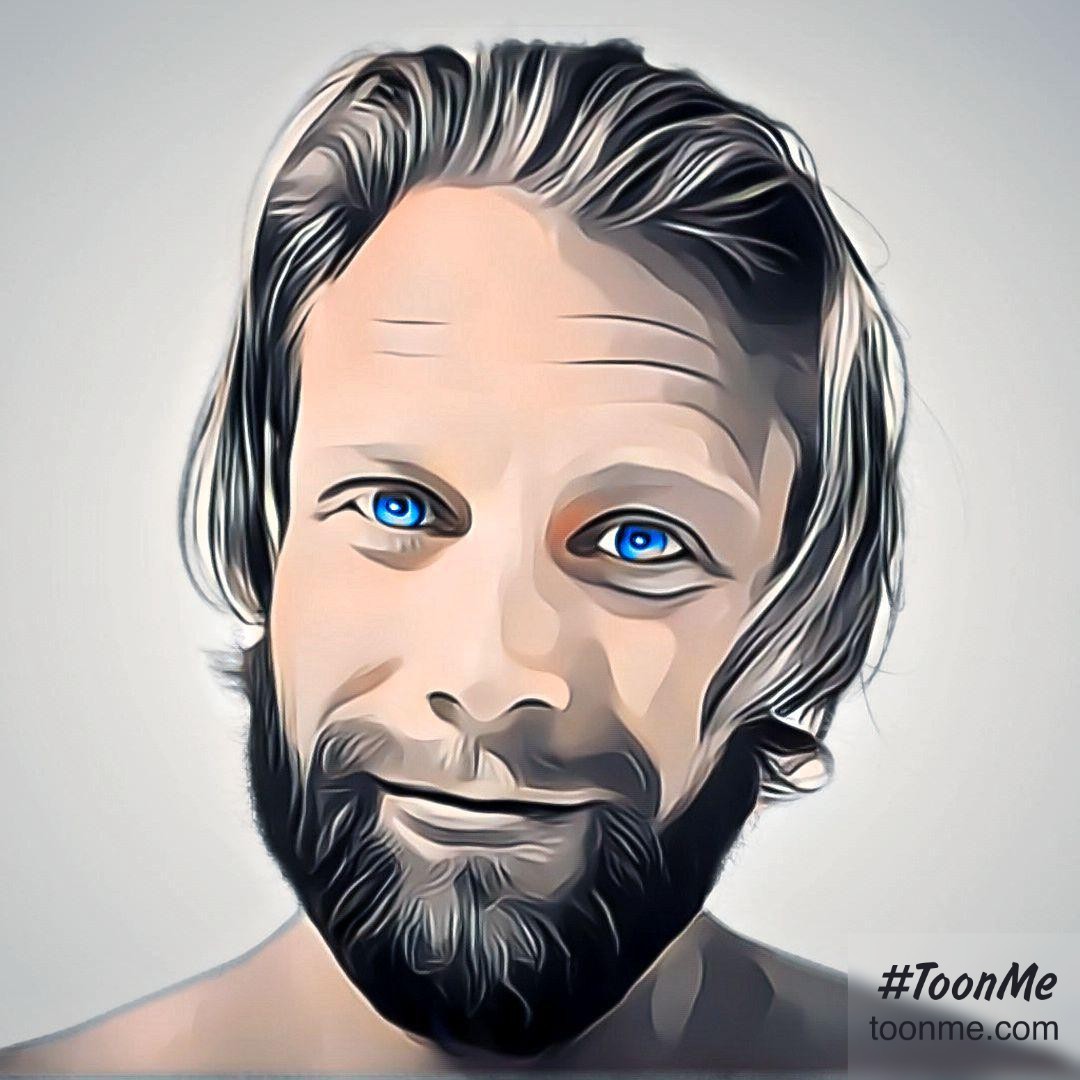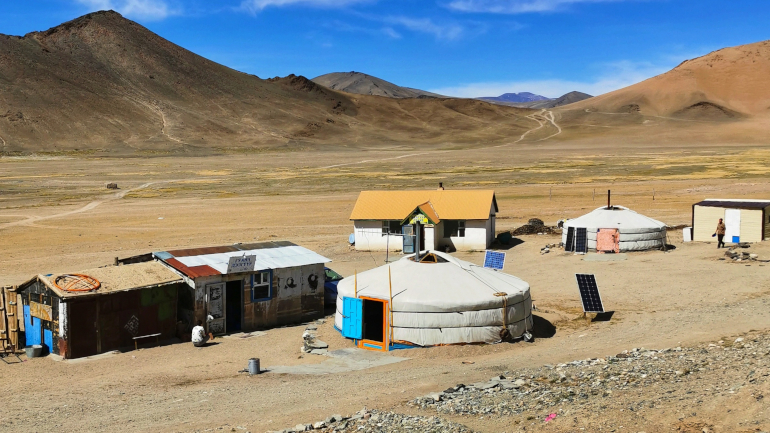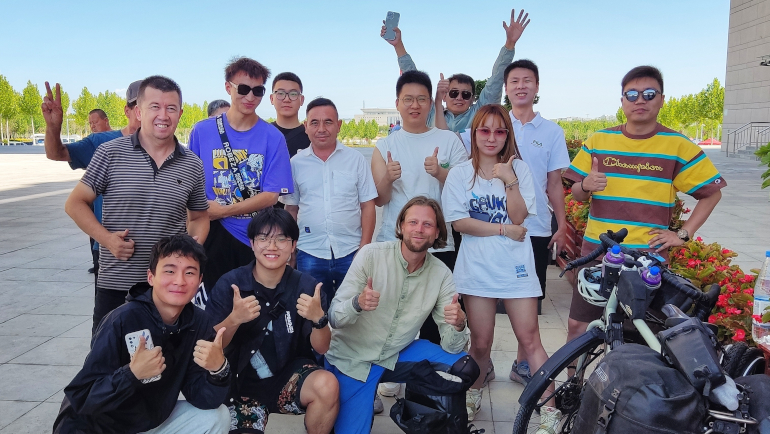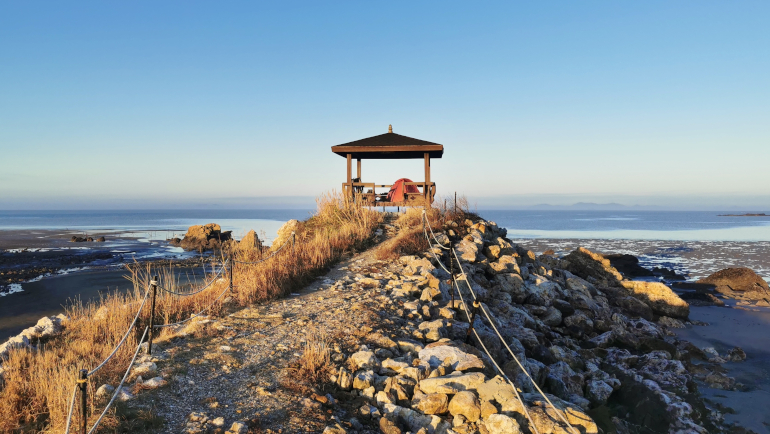Contents [hide]
Intro
Mongolia. Just the name has a remote feel to it. A vast country with the lowest population density in the world tucked away north of China with Siberian cold winters. Nomadic herders riding on horses while guiding their flock of animals to grassy pastures. People honoring their traditional styles of lifes lodged in their white felt tents. Eagles in the sky and yaks on the high plateaus. Cycling across this massive country ended up being one of my all time favorite touring destinations.
Recap of week 116 to 122
The rolling steppes of Mongolia were waiting ahead. I’d arrived at the westernmost border between China and Mongolia at Takeshiken Port. I got cleared at the Chinese checkpoint to get into the border zone and from there it was still an easy hour to cycle before I was at the actual border crossing where my passport got scrutinized thoroughly before I finally was allowed into Mongolia.
My task was easy. Cross Mongolia in less than two months. The road selection was limited. A few main roads exist and only one of them was a realistic option for me which was the one connecting Ölgii in the far west to Ulaanbaatar in the north-east and then catching another southbound main road to the Chinese border at Zamiin-Uud. I hardly needed any navigation app nor any maps for that matter.
First I had to climb over a snippet of the Altai mountains to connect with the Ölgii - Ulaanbaatar road. I cycled for days and only saw a few tiny settlements. Planning water and food for the road ahead was crucially important as I continued my tour across the mountains and towards the vast steppes.
After getting onto the main road I headed east towards Ulaabaatar. It dawned on me just how vast and big this country is. I cycled and cycled and then I cycled some more. Over seemingly endless steppes dotted with the signature white gers and herders roaming the scattered grassland with their packs of sheep, goats and camels. I continued like this until I reached Ulaanbaatar.
Winter comes early to Mongolia. I got to experience the beginning of it as I headed south to China from Ulaanbaatar in the beginning of October. Snow was on the hillsides and my water bottle was solid ice in the morning. I hurried towards a warmer climate and after a week and a couple of days after leaving the Mongolian capital city, I was at the border to China and ready for round two of my Chinese biketouring adventure.
Entering Mongolia and the sense of nothingness
My dream destination was ahead of me. For decades I’ve been thinking about this remote and mythological destination. I didn’t know much about the country I was about to cross. I knew they had extreme cold winters and that they had a very low population density. I knew they were nomadic people living in tents. And of course I’ve heard about Ghengis Khan who once ruled over much of the known world. But none of that really prepares you for what is to come. Mongolia is unique and something extraordinary you can only comprehend by going there.
It already was a completely different world the moment I left the Mongolian border control. My first impression was that of absolute silence. Only one small road was disappearing in the distant horizon. No cars. No buildings. No people. Only the gentle wind that rustled in the tumbleweed like vegetation. I cycled for an hour and only saw one herder on his horse far away kicking up dust in the air while navigating his flock of animals around the barren landscape in search of grassing areas. There were no trees and only green stubbs. Rocky surfaced and soft curved hills in every direction continuing in eternity like ocean waves. It was such an instantly different and clear and distinct feeling. Nothing like I’ve experienced before. I remember thinking to myself that if this continues all my expectations, dreams and desires will be fulfilled. This is what I came for.
I first had to get myself to a town to cash out local currency and if possible get a SIM card. Close to the border was a small town. I was not sure what to expect as I cycled down the main street. I wouldn’t think of it as a main street, but it looked like the town's businesses were bundled together along one road. There were a couple of eateries inside what looked like the living room of private homes. A small square halfway down the road with some tiny mini-markets, a basic clothing store and some cars selling a very limited selection of veggies from the back of their trunks. There was an ATM and it worked. Next to the ATM was a SIM card shop. I cashed out and bought a SIM card. I asked if there was a place to change money and I was referred to a side street with a modern looking bank. I had brought in some USD which I decided to exchange to local currency to have as a backup - just in case. Good to see that the basic travel logistics were accessible even in a small remote Mongolian border town.
I lodged myself into a hotel for the night to strategize the onward route.
Taking great care in planning my water and food rations
I asked a bit around town to get some advice on which roads had any nearby towns or villages where I could get water and food. Large parts of Mongolia are very dry and there is hardly an abundance of rivers to fetch water from. With some help from the hotel manager and iOverlander I decided on a route.
My initial idea was to just take the most direct route across Mongolia with the aim of reaching Zamiin-Uud and the border with China cycling the least amount of kilometers. However, I was advised to stick to the main roads if I wanted to be sure about getting provisions. The dirt roads through the Gobi desert were best done in a car that could have a greater daily reach and a bigger capacity to carry water. For me, that meant a huge detour up to Ulaanbaatar.
I was not so keen on that idea but I was also not keen on running out of water in the middle of nowhere. So Ulaanbaatar it was. I needed to head up to the main road going west-east from Ölgii to Ulaanbaatar. On my offline map I marked all the places to get water and food that I could get information on. Then I made a detailed day by day itinerary to follow. I usually never do that. I even planned this better than my tour across the Empty Quarter in Saudi Arabia. It gave me some peace of mind. I had gotten a camel-bak for the occasion and filled it up. On top of that, I loaded 10 liters of water in various containers and bottles on my bicycle and set off.
Getting to the Ölgii - Ulaanbaatar main road following a route that doesn’t exist on the map
I headed north and followed a main road. A local told me to follow the road until I saw a small village at the foot of the mountains. This would be my last option for provisions until I was over the top of the pass. I was going over the very end of the Mongol Altay before it ebbs out into and merges with the high plateau of the Gobi Desert.
As I took my break in the village, filling up my stomach with whatever sweets and crackers I could find, I had a look at Google Maps and tried to find the road I was going to take. It didn’t add up. I was going to follow it up north and then turn east but there was no road to the east. It turned west on the map and in the opposite direction of where I was headed. That could not be correct, I said to myself. People had told me there was a road and that it was particularly scenic. For 30 minutes I debated whether or not to continue north and hope there would be an eastward turning road or take a parallel road to my east which was marked on Google Maps. I had no water stops planned and marked on my map for the parallel road. What to do? When there is no clear answer to a choice then you go with your gut feeling. I decided to go into the unknown and hope for an eastbound road. This is what adventures are made of.
I climbed for a day along a river in a small valley landscape. Several times I had to get off the road. Not for cars but for passing sheeps that were led down from the mountains by a horse riding herder. During the night I slept next to the river and shared the sparse grassfields with munching cows. I showered in the lake in the afternoon when the sun had heated up the water enough to not be an ice bath. I used the river water for cooking and washing to save my water bottles. This was the only time in Mongolia I actually saw a river.
Next day I reached the summit of the mountain with a huge plateau in front of me. Hairy cattles also known as a Yak were grassing on the field and gave me a startled look as I was passing them on my bicycle. Eagles were soaring above me and followed me throughout the day. Early morning on my third day I reached my first settlement. Two dozen houses and some gers stood lonely at the foot of the hill dwarfed by the almighty landscape around it. So tiny and insignificant but I guess it actually was a sizable settlement relatively speaking. Living life up here must be special. I can’t imagine what it would be like.
The moments of truth had arrived. I was about to reach the non-existing road turning east. Guess what? It was there. Trust your gut feeling. That’s the lesson to be learned here. As there were no marked roads on my map, I figured I would just follow a general compass direction. Doing that I would sooner or later bump into a lake and a road leading to a large mine and behind that the main road. I followed the asphalt road for a full day before riding my bicycle over the steppes following only vague dirt trails. A lonely car passed me and confirmed that I was heading in a good direction. Good to know.
That’s the true beauty of Mongolia. It’s so remote and empty that Google doesn't even bother mapping out roads. And they shouldn’t. Then much of the magic would disappear. I loved it this way. But it was also the only time I would be on unknown roads because after this I was going to follow the main road to Ulaanbaatar and after that another main road to the border. I promised myself to come back another time to chase more unknown roads.
Traversing the Mongolian rolling steppes
After getting onto the Ölgii - Ulaanbaatar road I had a very long road to follow. At first I was in doubt if it in fact was the main road. It was only a narrow double lane road. One lane for each direction. True, it was paved with asphalt but I had imagined the main road to be like a highway. In fact, I should be grateful for it even being paved. I looked up some statistics to get rid of my doubt and found that out of a total of 50,000 km of roads in Mongolia, only about 10,000Km (20%) were asphalt paved roads. If I found tarmac it must mean I was on a main road.
Also another thing I took notice of was the lack of cars. I cycled and cycled for days on that main road and I was almost alone. On average there were only a few cars passing me every hour. And it would continue like this until I got closer to Ulaanbaatar. Going back 10 years there were less than 400k registered cars in the entire country. And up to the current date that number should not even have doubled. This was a true paradise for a biketourer. Asphalt paved road in a scenic landscape with no cars.
Traversing this part of Mongolia is a monotonous experience. You get to understand why it is called the rolling steppes. It’s very flat with some low hills and at times some sparse mountain scenery. The plains are endless and once you have passed one small hill and get a new vantage point, a whole other equally big landscape opens up in front of you. This keeps on and on and on. For me this is perfect. I love this kind of endless scenery for the same reason as I love the ocean. It’s just boundless and you truly get a feel of the size of nature. For others this might be the most boring and bleak landscape there is.
There’s not much more to add. For many many days I woke up in my tent, cooked oats for breakfast, packed up the tent, cycled until sundown, pitched the tent, made dinner and went to sleep. Next day I would repeat it all again and again. This feeling of endlessness is why Mongolia ended up being my favorite touring destinations above them all.
Gers and herders in a country with the world’s lowest population density
One other thing that made my days and weeks in Mongolia extra special was the white dotted tents I could see from the road. They were never plentiful and in large enough numbers to dominate the landscape but frequent enough for me to pass some each day. Ideally suited to Mongolia's harsh terrain and lifestyle with its round wind repellent design and waterproof, white, durable felt canvas. After being in other Central Asian countries it’s tempting to call it a yurt, but Mongolians don't particularly like this labeling of their national dwelling so remember to call it a ger.
Modern buildings are made in cities and towns but many Mongolians still retain this way of traditional living and stay somewhat true to their nomadic heritage. Even in cities, they would erect a wooden fence around their plot and then simply put a ger inside instead of building a house. And that made the feel of Mongolia extra special. It is so rare in this modern world to see people living a simple life in balance with the nature around them. I salute the Mongolians for doing so and I hope they will never give it up.
In the vicinity of the gers I often saw herders either on a horse or on a small motorbike leading their flocks to fresh pastures. At night they would huddle into their gers and put on a fire using animal dung as firewood. That’s what you have to do when there’s no trees around. When I pitched a tent for the night they would come riding to say hello and offer me food, vodka or some dried up cubes of cheese.
Even though I did have encounters with Mongolians I was not surrounded by people. Mongolia is the country with the lowest population density in the world (if you don’t count Greenland). I guess that’s why I had this sense of remoteness. It’s a special feeling and one that I was at ease with. I didn’t feel lonely or isolated. The remoteness made me connect even more with nature. All distractions gone. Inspired to be humble by the greatness around me and having a sense of peacefulness. That’s what made cycling over the rolling steppes to Ulaanbaatar so utterly amazing. What a unique experience.
However all of this came to an end when I approached Ulaanbaatar. I suddenly realized where all the cars and people were. Ulaanbaatar has 1.4M out of a total population of 3.3M. In this huge country most of the people have concentrated themselves in Ulaanbaatar. There were traffic jams on the road and the rest stops were filled with people. It was almost as if I'd entered a different parallel universe.
The modern feel of Ulaanbaatar
It was late September when I reached the outskirts of the capital. The single lane road had turned into a double lane road in each direction. Tall fuming chimneys from busy industries were visible high in the sky. The mountain hills around the city were cladded with a white cover of snow. Winter comes early to this country. It begins in October. Winter is brutal here and it easily gets down to minus 30 degrees. It’s a harsh climate to survive in but the Mongolians made it work and to show for it they have created a bustling and modern city.
It was a big surprise to see how modern everything was. After all the weeks with gers and small towns and villages it was strange to see KFC and Pizza Hut and tall skyscrapers. There were hipster cafés and trendy bars. Vegan eateries and young people in fashionable clothes. The city was very much a modern capital in many ways.
I had a lot of errands to run. My tent zipper was broken and I couldn’t close my inner tent properly. The summer sneakers were all worn down and ripped in many places. Even the sole had a hole straight through it. My gas stove was misbehaving and needed either to be fixed or replaced. I visited the local market to get supplies and during the night I was hanging out at bars meeting up with other cyclists who had converged here to take a break.
Time was too short for this city and this country. I had extended my visa for an additional month so I could stay for a total of two months. Still too short to explore this country. I wanted to stay for at least one more month. However, there was also a long way down to the border with China and I had to leave.
Escaping the approaching winter and a difficult goodbye to Mongolia
Leaving Ulaanbaatar was also a heartfelt reunion with the familiar landscape I had cycled through before. I was back in my routine cycling until sundown and then pushing my bike over the steppes to find a spot for my tent. The free roaming horses were again curiously coming up to my tent and when darkness came it was like they gained some courage and started grazing next to my tent. It was like they wanted to keep me with company.
The temperatures were already below freezing. A frosty layer covered my tent in the morning and I waited for a couple of extra hours for the sun to rise and gain enough warming strength to dry my tent and evaporate whatever little moisture was on my sleeping bag. During those long mornings, I pulled out my camping chair, made a big portion of oats and doubled up on coffee. Drinking coffee and looking into nature's emptiness is a favorite morning pastime for me.
I made sure to enjoy as much of this. Because each day I cycled meant I was getting one day closer to the border and therefore had one less day to enjoy Mongolia. China was going to be different. And I probably won’t get this kind of experience again on my trip. It made my eyes tear up just the tiniest bit.
Arriving at the border happened way too fast. I wanted to stay longer but my Chinese visa deadline was fast approaching. Gosh darn it, that visa deadline was depressing. But it is what it is and I had to be grateful for the opportunity to enter China and be able to cycle all the way east. I tried to comfort myself with that idea as I loaded my bicycle onto a bus. The border crossing at Zamiin-Uud into China was only allowed to be done in a vehicle.
Goodbye Mongolia! I’ll be back. That’s a promise.
biketouring china
2023-11-04 | blog
Biketouring journal covering China and the crossing of Xinjiang from Kazakhstan and the Assy Plateau to Mongolia and the roads through Inner Mongolia to Beijing
and Qingdao. I traveled on my bicycle through police controls, empty deserts and den...
biketouring south korea
2023-08-04 | blog
Biketouring journal covering South Korea and the roads from Seoul to Busan with a detour to Jeju Island and looping back north to Sokcho and the DMZ. I cycled the
entire set of certified bike paths which were The Cross Country, The 4 Rivers and ...



